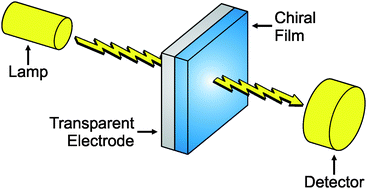The identification of viable mechanisms to control the chiroptical properties of organic compounds with electrical stimulation can lead to the development of electroactive materials able to modulate the polarization of electromagnetic radiations under the influence of electrical inputs. Indeed, experimental protocols to regulate the circular birefringence and dichroism of chiral compounds are starting to be developed on the basis of redox processes. These studies, however, have focused their attention so far on the analysis of the chiroptical properties of metal complexes and organic molecules in solution. At this stage of their development, it is not entirely clear if and how these mechanisms can be extended to the realization of functional electrochiroptical materials. On the basis of these considerations, we designed two chiral and electroactive building blocks with anchoring groups able to adsorb on metallic electrodes. Specifically, these compounds have a 1,1′-bi-2-naphthol core with two 4,4′-bipyridinium appendages each terminated by a thiol group and differ in the nature of the spacer connecting the chiral core to the electroactive units. The 1,1′-bi-2-naphthol core imposes a chiroptical response on the 4,4′-bipyridinium appendages of one of the two compounds, but not on the other. The pair thiol groups ensure the adsorption one of the two compounds on gold and platinum electrodes in the form of electroactive multilayers and electrochromic monolayers respectively, while the other can only form monolayers on gold. Thus, the structure of the spacers separating the chiral element from the electroactive units dictates the adsorption and chiroptical behavior of these compounds.

You have access to this article
 Please wait while we load your content...
Something went wrong. Try again?
Please wait while we load your content...
Something went wrong. Try again?


 Please wait while we load your content...
Please wait while we load your content...